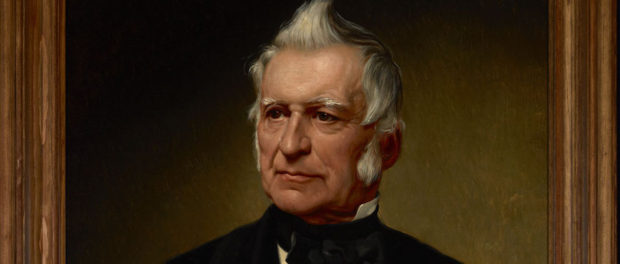1848: The Return of Papineau & Other Quebec Curios
Part of “Division and Resistance”, 1827-1863
 Detail of a portrait of Louis Joseph Papineau by Alfred Boisseau. Oil on canvas, 1872. Source: Library and Archives Canada/MIKAN Number: 2890428
Detail of a portrait of Louis Joseph Papineau by Alfred Boisseau. Oil on canvas, 1872. Source: Library and Archives Canada/MIKAN Number: 2890428
After being granted amnesty in 1845, Louis-Joseph Papineau returned to the Province of Canada but found it changed from the climate that he had left it in. After his flight to the United States in 1838, Papineau had travelled to France towards 1840 in order to collect information intended for a publication about the history of the French-Canadian people. During this time, he had additionally managed to publish a work about the Rebellions. When he heard about potential amnesty being granted by the Province of Canada’s governor general, Charles Metcalfe, in 1842, Papineau petitioned and his request was granted. The former leader of the Patriotes came back, though came back a changed man. Trying to build a good life for his family, he set out to build a manor house in Montebello that was completed in 1860.
Papineau saw the union between the two Canadas as a threat, and he thought that responsible government, in the form propagated by the new generation of politicians, as something laughable. Still retaining his anti-clerical ideas, he nonetheless saw them as part of the brick and mortar of French-Canadian society and had an uneasy relationship with them: the clergy didn’t care for him and he didn’t care for the clergy, and yet somehow felt an attraction to its role as a unifier. He came back instead with a radical idea: that Lower Canada (Canada East) should be annexed to the United States, a country that was as anti-England as it could be. Despite the exact same problem that unification with another predominantly English-speaking colony would have to the culture of the French-Canadians, Papineau nonetheless admired the American political institutions as he understood them during his time in exile with his family. His rather radical idea made former colleagues split with him ideologically, since his colleagues now thought there might just be a way to try and preserve the very same French-Canadian culture but now within a united Province of Canada.
Standing for office in 1848 after requests by his friends and family, Papineau won the riding of Saint-Maurice and was able to represent his constituents in the House of Assembly. Once again, he propagated the idea for annexation to the United States. His radical ideas, however, did not go unnoticed. Many educated French-Canadian professionals, unsatisfied with the moderate stance of other parties, had formed a party called the Parti rouge in the early 1840s and now quickly rallied themselves around the old leader of the Patriotes.
Papineau’s actions would alienate many of his older colleagues that had once supported him during the Rebellions. Papineau would move on to represent another constituency, Deux Montagnes, for a second run as a politician from 1852 to 1854, but did not seek re-election after that. While the Parti rouge allied against him, his presence was no longer a match to the new politicians, one of which would manage to ally Canada West and Canada East: Louis-Hippolyte La Fontaine.
Visit Papineau’s manor house here.





